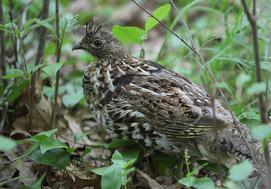RUFFED GROUSE ID-305
Cambridge, Idaho
May 29, 6:21 to 8:23 a.m.
Sunrise at 6:05 a.m.
That was just one drum, to satisfy those who must listen quickly and move on.
But then there is grouse time, not the quick drum or two that a human might want to hear for bird identification, but instead two hours in the life of a ruffed grouse as he drums on a log in central Idaho:
At 0:05 in this two hour recording, Mr. Grouse flies into the area of his drumming log. Patiently we wait, and over three minutes later, at 3:23, he has found his drumming post. But oh so softly he lets the first one go, as if warming up his torso for the far more spectacular drums that will eventually follow. He follows with other drums, at 4:51, 6:27, 8:19, 10:05, with a total of 36 drums over two hours. After half an hour he drums at nearly full strength, but after an hour he's definitely there.
So much of the energy in this drum is below my range of hearing, but given how close this grouse is to the microphone, I can hear him with ease. As I watch these drums dance by on my computer monitor, I'm excited by what I see in the background, well below my range of hearing. I had been seeing something suspicious down there along the baseline, below 100 Hz, but it didn't dawn on me until about seven minutes into this recording that those are OTHER DRUMMING GROUSE IN THE BACKGROUND! Those low frequencies travel great distances, and there's no doubt in my mind that these grouse can hear a great symphony of competing grouse drumming at considerable distances. And, most importantly, the female grouse has no trouble hearing her choices as to who will be the father of her young.
Try a little sleuthing in Raven software, if you are so inclined. At 6:27 Mr. Grouse booms loud and clear. Then watch in the waveform (not the sonagram) window for some faint energy that looks like it has the same rhythm as a grouse drum. There, by 7:32 is a second grouse, and still another grouse begins drumming just a few seconds later, at 7:41, followed by our loud grouse at 8:19.
I look for patterns. At 12:16 the foreground grouse drums, and a distant grouse drums almost simultaneously, with a three second delay. But mostly they seem to drum irrespective of each other, each at his own pace. In this selection one of those background grouse drums last at 2:01:40, followed by our foreground grouse at 2:02:16.
Background
Over two hours: American robin, warbling vireo, yellow warbler, spotted towhee, mooing cattle, Lewis' woodpecker, black-headed grosbeak, western meadowlark, western tanager, a hummingbird (most likely a Calliope, given their abundance here), Steller's jay, chipping sparrow, mourning dove, and more if you listen carefully. A jet airplane begins to pass after an hour and 52 minutes.

Photo by John Van de Graaff
